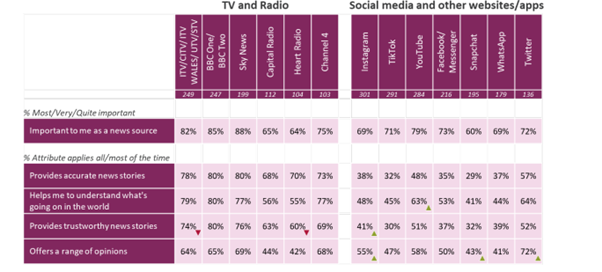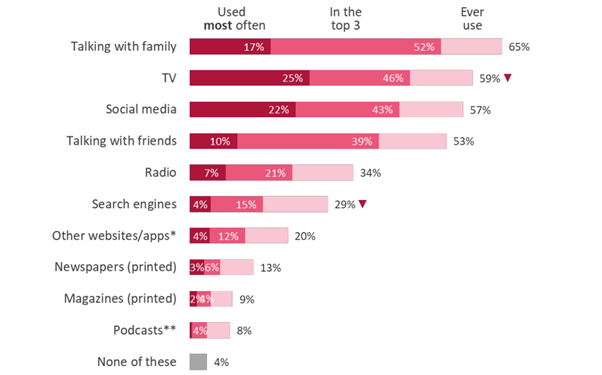Is Changing News Engagement Altering Trust?
30 Aug 2022

Ofcom has released its latest report into the UK’s news consumption habits, providing insights into the forms of media individuals use for their news and how this may differ between different age ranges. The data provides perspective as to how different age groups actively search for their news, the platforms they prioritise, and their reasons for doing so – some valuing more known, traditional and accurate styles of news, others valuing convenience and social elements instead.
Within the report, the findings provide insight into the key differences in news consumption, including a breakdown of teen behaviour. One key takeaway is the rampant rise of social media as a news source, with 57% of teens using social media as a news source. Instagram (29%), TikTok (28%) and YouTube (28%) are the top three most-used sources for teens. TV news sources have begun to fall considerably, with BBC One & Two falling by 11% from the previous year alone but remaining at a still meaningful 24%.
In contrast to social media, those consuming news via printed newspapers and magazines are each below 15%. This perhaps highlights the different values of teens in comparison to those of older ages, with 40% of those aged 65-74 and 51% of those aged 75+ opting for print newspaper – both above the average newspaper consumption of all adults.
This difference may be due to a mixture of convenience and habit. The ease of access to social media to anyone with a phone means younger consumers are likely to have grown up with the habitual convenience of getting the news from social platforms. While older consumers, despite the access and convenience, have held onto their habitual relationship to print formats.
How do teens and other age ranges compare to one another?
Those who are younger appear to have significantly higher favourability towards news being consumed from the internet or online sources – though it must be expressed that these alternate sources are still of relevance to the older generations too.
The ways in which younger adults consume alternative sources, such as newspapers, display additional differences by age, with those aged 16-24 and 25-34 having a 20:10 and a 17:16 ratio of viewing newspapers online instead of print. In comparison, those aged 65-74 and 75+ have an 11:40 and 8:51 ratio of consuming news from newspapers online. This trend continues with the youngest adults preferring social media in 6 of their top 10 overall news sources, but among the oldest age range, social media doesn’t appear in the top 10 at all.
News consumption of adults by platform (Source: Ofcom)

Why would alternate sources remain of high relevance despite falling numbers?
To begin with, the nature of social media news consumption is different to that of more traditional forms such as newspapers, radio, or TV. Social media’s news varies largely and can often consist of reposting or rebroadcasting news found on these alternate platforms. This can occur in more condensed forms (Instagram & TikTok) or more expanded forms (YouTube) depending on the different creators and platforms they have used. Unlike the other platforms, social media has a reliance on the content from alternate news sources.
Additionally, social media has its own drawbacks. Its trustworthiness is brought into question in comparison to alternate sources, with even teens remaining sceptical over the news on social media. This is something that TV is still excelling at, with 70%+ people finding BBC, ITV, and Sky TV news to be trustworthy.
This can be brought into context with the most trusted forms of social media amongst teens (YouTube 51%, Twitter 52%) not coming close to the levels of trust TV has.
The overall trust for social media captures the disparity it has in comparison to alternate platforms – with just 39% overall trust from 12-15-year-olds, it has only been able to gain half the trust levels that TV (79%), newspapers (78%), and other websites/apps (77%) have gained.
Overall, this is the key area in which TV and radio find complete success over social media amongst 12-15-year-olds, with the lowest, Heart Radio (60%), still 8% higher than the most trusted form of social media (Twitter 52%), and still twice as trusted as the lowest (TikTok 30%).
Trust in news source from teens (Source: Ofcom)

How important is trust?
It seems trust has varying levels of significance across different age ranges. Those youngest, despite reporting low accuracies in friends and low trust in social media, use both 3rd and 4th most frequently (53% and 57%). This may further highlight differences in the desire of outcome people look for in their news and provided the number of teens viewing news ‘popular with friends’, despite reporting it to be one of the least trustworthy sources, shows news to have a more social and awareness value, rather than an informative one. Though, with TV being the 2nd most-used form of news and highest rated for being used most often, this shift may also relate more to the variety of perspectives available and habitual convenience teens have with social media, as mentioned earlier.
News platforms used by teens (Source: Ofcom)

How can marketers learn from News’ trends?
For marketers, while taking advantage of the popularity of social media by using a multiplatform model to engage customers appears to be the most obvious way to gain popularity amongst the younger generations, it may require more than that to make this approach successful.
The way trust and value appear to change with age, simply expanding your brand’s exposure might not be enough for sustained growth within younger generations. Instead, having a strategy that is able to grow and retain trust, while also being able to cater to younger people’s values may be a route to more loyal consumers – both young and old.
To find out more on how you can build trust and loyalty within customers, why not attend the DMA’s Customer Engagement 2022 - Building Trust and Loyalty in Challenging Times event in September.
Or to improve your customer insight and strategy skills, try one of the courses and qualifications the IDM has to offer:



1.png)